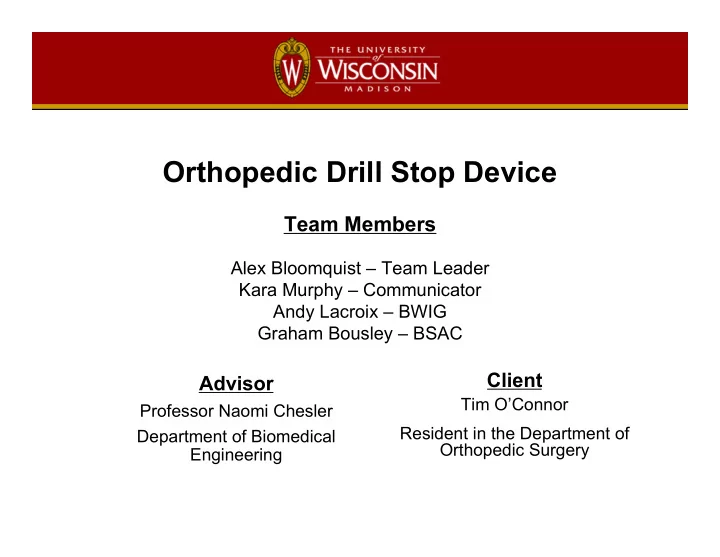

Orthopedic Drill Stop Device Team Members Alex Bloomquist – Team Leader Kara Murphy – Communicator Andy Lacroix – BWIG Graham Bousley – BSAC Client Advisor Tim O’Connor Professor Naomi Chesler Resident in the Department of Department of Biomedical Orthopedic Surgery Engineering
Overview • Problem Statement • Background • Prototype - Fall 2010 • Design Improvements • Testing • Future Work • References • Questions 2
Problem Statement Our client is concerned about over penetration of the drill bit into soft tissue during bicortical drilling in orthopedic surgery. For most surgeries the current methods of preventing over-penetration is based solely on sensory skills of the surgeon. Our team has been asked to create a design that minimizes the plunge depth of the bit after penetrating the far side of the bone to prevent injury to soft-tissue. 3
Background • Current method : drill sleeve or pre-determined drill stop • Client Requirements: • Reduce plunge depth to < 3 mm • Incremental advancement • Unobtrusive during surgery • Can be operated with one hand 4
Prototype – Fall 2010 Locking clutch – prevents tube from sliding forward from force of drill at equilibrium. Unlocks with trigger pull. Advancement clutch – pushes tube forward from trigger pull Locking clutch – prevents tube from returning to equilibrium when trigger is released Measurement readings 3 precision springs Housing and handle: 3D printed with ABS 5
Design Improvements • Prevent slip of inner tube from drill force • w/ clutch engaged • w/ trigger pulled • Prevent unintended disassembly • More ergonomic • More user friendly • Prevent bone dust accumulation 6
Testing • Plunge Depth/Time test Set up: Attach bone on top of foam. Place cover over bone to reduce visibility. Procedure: Run test with chosen device. Place device on bone Drill the bit into bone Once far cortex in penetrated, stop drill Measure the length of the hole through bone Results: Measure distance that bit has plunged into foam Time entire procedure * Repeat procedure for both devices to compare results 7
Future Work • Finish trigger design • Build prototype #3 • Conduct plunge depth/time test 8
References • Allotta, Benedetto. (1997) A Hand-Held Drilling Tool for Orthopedic Surgery. IEEE/ASME Transactions on Mechatronics. 2 (4), 218-229. • Dubrowski A, Backstein D. (2004) The contributions to kinesiology to surgical education. Journal of Bone and Joint Surgery. 86 (2), 2778-81. • Darvish, K., Shafieian, M., Rehman, S. (2009) The effect of tip geometry on the mechanical performance of unused and reprocessed orthopaedic drill bits. Journal of Engineering in Medicine. 223 (5), 625-635 • Greenburg A, inventor, 2003 Dec. 30. Sleeved stop for a drill bit. United States patent US 7,210,881. • Ryan C, inventor, 2004 Mar. 30. Adjustable depth drill bit. United States patent US 7,163,542. 9
Questions? Prototype #3 Prototype #1 Prototype #2 10
Recommend
More recommend